Dear Commons Community,
Former Secretary of Defense Robert Gates’ upcoming memoir dominated media coverage especially with the cable news channels yesterday. A review of the book written by The Washington Post’s Bob Woodward states that Gates “unleashes harsh judgments about President Obama’s leadership and his commitment to the Afghanistan war.” According to summaries of Duty: Memoirs of a Secretary at War, printed in the Post, The New York Times and the Wall Street Journal, Gates seems to have two main criticisms of Obama: that divisions were created because he did not believe in, and was suspicious of, his generals; and he did not believe in his own strategy in Afghanistan, caring only about getting out. (The book will be available in bookstores next week).
“Bush was willing to disagree with his senior military advisers, but he never (to my knowledge) questioned their motives or mistrusted them personally,” Gates wrote in a Wall Street Journal essay, adapted from the book. “Obama was respectful of senior officers and always heard them out, but he often disagreed with them and was deeply suspicious of their actions and recommendations. Bush seemed to enjoy the company of the senior military; I think Obama considered time spent with generals and admirals an obligation.” However, a number of observers have already pushed backed and have even complimented the president for the way he is depicted in the Gates’ book. As reported in The Huffington Post:
“… these “harsh” criticisms fall flat for some foreign policy observers, and could even put Obama’s defense record in a good light. The president is the commander in chief of the armed forces, and holds final authority for decisions to send troops — not the generals. Gates’ criticized Obama for being overly suspicious of his generals; others commended him for his scrupulousness and leadership.
On his approach to Afghanistan, Obama made clear that he believed it was in the U.S.’ best interest to strategically withdraw, and his overwhelming election was a mandate from the American people to do so. And he wasn’t exactly hasty, as Gates seems to imply: In a 2008 debate with Sen. John McCain (R-Ariz.), Obama called for more troops, but also to reduce them after 16 months. He announced at a December 2009 address at West Point that he would order an additional 30,000 troops, and they would leave after 18 months. By ordering additional troops, Obama was hardly “all about getting out.” Moreover, Gates was secretary of defense when Obama made decisions about troop levels.”
“… it’s odd to say that Bush’s relationship with his generals was better than Obama’s,” said Heather Hurlburt, senior adviser to the National Security Network. “Because Bush’s relationship with his generals is what brought us the loss of focus in Afghanistan and the debacle in Iraq.”
Lawrence Korb, an assistant secretary of defense under President Ronald Reagan and senior fellow at the Center for American Progress, said that Obama was right to be skeptical toward the military. “Like any bureaucracy, they have a point of view, they see things in a certain way,” he said. “If we had listened to the military in the Cuban missile crisis, none of us would be here.”
Moreover, Korb added that Obama’s generals leaked information to the press to bolster their positions. “There’s no doubt that [David] Petraeus leaked stuff to the press that got Obama mad, as it should have. It should’ve got Gates mad,” he said. “Also, when [Stanley] McChrystal asked for more troops after Obama had already sent more troops to Afghanistan, that got also leaked and put him in a tough spot.”Petraeus leaked documents on Iraq troop pullout plans, while a McChrystal plan for more troops in Afghanistan was published by Woodward in the Post.
“…But for a former Secretary of Defense to be so critical of the current commander-in-chief, particularly on an issue like Afghanistan when negotiations over future security arrangements remain unresolved, strikes me as bad timing and bad form,” Sen. Jeff Flake (R-Ariz.) wrote on Facebook. “Worse yet, it makes it less likely that this President, or future Presidents, will reach across the political or philosophical aisle when filling out his or her cabinet. The country benefits when people with discordant views are in a position to challenge and shape a President’s views in private, when in matters most. This book makes that less likely to happen.”
In sum, while some conservative hawks will make Gates’ memoir seem like a grand expose of the President, in closer reading, it seems that Obama was functioning exactly the way the majority of Americans would want him to especially with regards to the mess he inherited in Afghanistan.
Tony





